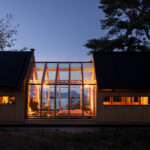‘Building Tomorrow’ presents the contemporary trends in building design and the global forces driving them forward, using Architizer’s annual A+AWARDS submissions as the benchmark. The data is creatively visualized to provide valuable insights for designers, retailers, and any industry working to create experiential designs. Download the full report for free at www.psfk.com/report/building-tomorrow.
The world is changing fast, and all good architects know they must stay in tune with its evolution, constantly adapting their thinking to respond to new social, technological, and environmental conditions at every scale. These complex issues demand increasingly innovative solutions from designers in order to assure that the built environment is economical, sustainable, and comfortable for its inhabitants, responding not only to their practical needs, but also to their political and social values.
The question is: what can today’s architecture teach us about how the best in the profession are designing for these big issues?
Following an in-depth analysis of last year’s A+Awards winners, Architizer and PSFK Labs identified three global driving forces that are influencing architects and urban planners at every scale. Visualized in a brand-new report on current trends in architecture — a free-to-download paper packed with sharp graphics, fascinating statistics, and stunning images — these categories represent the overarching priorities that architects must now address in their design process in order to create great cities for tomorrow:

Times Square Valentine Heart by Young Projects, New York, United States
1. Connected Lifestyles
“Digital experiences now pervade almost every aspect of daily experiences. Thanks to the ubiquity of smartphones and other connected devices, people are now able to tap into more information about themselves and those around them than ever before. This interconnectivity blurs the boundaries between life, work and play, and facilitates collaboration over any distance. The pushback to the connected lifestyle has also been observed as people value increasingly scarce private time and escapes from technology.”
Influencing factors changing architecture on an urban scale includes our working patterns. The freelance economy is booming, many homes now doubling up as offices. This change, in turn, is affecting work/life integration, and mixed residential, commercial, and social programs are increasingly becoming common.
In relation to our online age, the need for digital respite (space away from the internet, phones, and other electronic devices) is increasingly called for, while privacy is also a key concern. How can architecture respond to issues of transparency and concealment in both physical and digital environments?

Ring of Celestial Bliss by J.J. Pan and Partners, Hsinchu City, Taiwan
2. Empowered Citizenry
“More and more people are growing up in a truly global marketplace. Those who participate have a broader awareness of the world and their ability to impact it. Millennials and subsequent generations are growing up partaking in the sharing economy, demanding transparency from organizations, and voting with their dollars. Knowledge of social and environmental issues is compelling millennials and future generations to make even small decisions with an eye for the greater good.”
As a result of the first driving force — our increasingly connected society — a new generation of architects is emerging for whom environmentalism and sustainability is a top priority, and they are seeking to integrate these factors at the outset of the design process.
The internet has also given birth to a more democratic design process. Community empowerment is greater than ever, and everyone is able to have a voice in architecture and the built environment. The sharing economy in architecture is also taking off; social media campaigns and crowdfunded projects are ever more popular as ways for small firms and nonprofits to make waves in the profession.

Rundeskogen by Helen and Hard, Sandnes, Norway
3. Urbanized Population
“People around the world are experiencing the increased strain on resources brought on by population growth and urbanization. While the growth of cities has birthed an energetic urban identity, it has also inspired an appreciation for older, natural constructions incorporating existing buildings and landscapes.”
As a result of these evolving conditions, architects must now consider ever more efficient modes of design. Due to resource scarcity, there is a growing urbanization as a result of which energy, water, and space can be shared, recycled, and adapted as necessary. This urbanization has also led to a greater focus on the creative reuse and retrofitting of old buildings as well as a rural resurgence with a growing number of people transforming agricultural architecture into striking residential spaces.
In the coming weeks, we will explore how these three broad themes have acted as the catalyst for major trends running the gamut of architecture and design. In the meantime, make sure to take advantage of the free download of ‘Building Tomorrow’ — the essential guide to trends in contemporary design!









